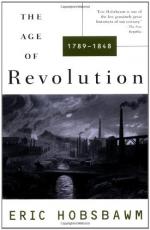|
This section contains 394 words (approx. 1 page at 400 words per page) |

|
The Arts Summary and Analysis
The arts flourish during the period covered by Hobsbawm. An increasingly literate public allow for the rise of several significant contributors to the arts in literature, music and painting, including Goethe, Wordsworth, Dickens, Beethoven, Mozart, Chopin and Delacroix. These high achievements in the arts span across all the nations of Europe, and even today are looked at as defining classical taste.
Hobsbawm relates this astounding advancement in the arts to the dual revolution. He simplifies the connection by suggesting that the French Revolution provided an inspirational example to the artists of the day, while the Industrial Revolution provided stimulation through the "horror" of the plight of the working classes. Artists of the day are closely connected to public affairs, Hobsbawm explains. Mozart writes The Magic Flute, a piece promoting Freemasonry and its political aims, Charles Dickens writes about life...
(read more from the The Arts Summary)
|
This section contains 394 words (approx. 1 page at 400 words per page) |

|




